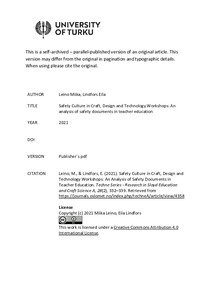Safety Culture in Craft, Design and Technology Workshops : An analysis of safety documents in teacher education
Leino Miika; Lindfors Eila
https://urn.fi/URN:NBN:fi-fe2021120158399
Tiivistelmä
The teaching and learning of craft, design and technology (CDT) subject iscarried out in materially and technologically rich learningand workingenvironments. The importance and role of safety culture inexperiential learning in CDT education is essential for all membersofaneducational organization to endorse. The safety cultureof workshops should includeinspection and maintenance of facilities, monitoring safety incidents andsafety training as part of occupational safety to avoid near-misses, accidents and injuries.The aim of thisstudy is to considerthesafety culture ofthelearning and working environments of CDT education based onwritten safety documents (N=3) in order to generate a better understanding of safety culture. Thestudy question is: What categories and subcategories of safety culturecan be recognised in CDT education learning and working environmentsin teacher education?The study was based on data from three safety and security documents: University Campus Rescue Plan, Safety Management Document in CDT Education and External Safety Audit Report of CDT Education. The data were gathered from these documents and categorized according to the Edusafemodel’smain categories: preparedness and prevention, incident management, recovery and safety management. The data werefurther divided into ten subcategories,and the final results were formed on this basis.The results reveal that,in general,safety issues are well identified,and many key measures are documented thoroughly. However, at the same time,recovery isn’t considered at all. It seems that the safety culture of CDT education needs reconsideration: What are therolesand procedures of recovery?
Kokoelmat
- Rinnakkaistallenteet [27094]
